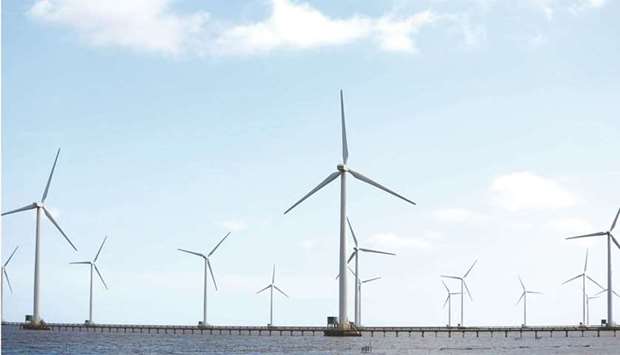Surging wind industry faces its own green dilemma: landfills

Siemens launches first recyclable wind turbine blade
• Anti-wind groups use dumping of blades as rallying issue
• Industry calls for EU landfill ban
Wind turbines have become a vital source of global green energy but their makers increasingly face an environmental conundrum of their own: how to recycle them.
The European Union’s share of electricity from wind power has grown from less than 1% in 2000, when the continent began to curb planet-heating fossil fuels, to more than 16% today.
As the first wave of windmills reach the end of their lives, tens of thousands of blades are being stacked and buried in landfill sites where they will take centuries to decompose.
Spanish turbine maker Siemens Gamesa this week launched what it called a “game changer” — the first recyclable blades, which use a technology that allows their carbon and glass fibres to be reused in products like screen monitors or car parts.
“We have reached a major milestone in a society that puts care for the environment at its heart,” said Andreas Nauen, chief executive of Siemens Gamesa, which expects the blades to become the industry standard.
Europe is the world’s second largest producer of wind-generated electricity, making up about 30% of the global capacity, compared to China’s 39%, according to the Global Wind Energy Council, an industry trade association.
Wind Europe, a Brussels-based trade association which promotes the use of wind power in Europe, expects 52,000 blades a year to need disposal by 2030, up from about 1,000 today.
“The public want to be reassured that wind energy is fully sustainable and fully circular,” said WindEurope’s chief executive, Giles Dickson, describing Siemens Gamesa’s new recyclable blade as a “significant breakthrough”.
While wind turbine blades are not especially toxic, the resulting landfill, if improperly handled, may contribute to dangerous environmental impacts, including the pollution of land and waterways.
All forms of energy have some environmental cost but renewables, almost by definition, cause less damage to the planet, said Martin Gerhardt, Siemens Gamesa’s offshore wind chief.
“If you look at oil wells and the spills or if you consider methane leaks, compared to the fossil industries, wind is the lesser problem,” he said.
Wind power is one of the cleanest forms of energy, with a carbon footprint 99% lower than coal and 75% less than solar, according to a study by Bernstein Research, a US-based research and brokerage firm.
Its emissions come mainly from the production of iron and steel used in turbines and concrete for windmill foundations.
If these were mitigated by techniques such as carbon capture and storage — where carbon dioxide is buried underground — “you’d be able to cut out the carbon footprint completely,” said Deepa Venkateswaran, the study’s author.
The growing mountains of waste created by old blades has become a rallying point for groups opposed to wind turbines, which they also say are noisy and spoil the countryside.
But landfill is likely to remain the preferred disposal option because it is the cheapest, said Eric Waeyenbergh, advocacy manager at Geocycle, a sustainable waste management firm.
“If you just throw it in the landfill, this is the cheapest price you can have when you’re dismantling the windmill. And that’s a problem because there’s no mandatory recycling or recovery obligation,” he said.
Geocycle and WindEurope are lobbying for landfills to be banned across Europe where only four countries — Austria, Germany, the Netherlands and Finland — have outlawed the landfilling of composite materials, such as wind turbine blades.
Geocycle co-runs a cement kiln in Germany, with building industry giant Lafarge, which is partly fuelled by burning thousands of tonnes of old wind turbines, which create less carbon dioxide than fossil fuels.
Recyclable blades can also be ground up for use in products such as rearview car mirrors and insulation panels, or heat-treated to create materials for roof light panels and gutters.
However, industry groups say these techniques are not currently available at commercial scale or at a price that would make them viable alternatives to landfill.
David Romero Vindel, co-founder of Reciclalia, which cuts and shreds turbine blades for recycling as carbon fibre yarn and fabric, said a landfill ban would help his firm.
“We need the EU to push the sector in this direction of recycling,” he said.
Vivian Loonela, a spokeswoman for the European Commission said it will review its landfill policies in 2024.
“The recycling of (windmill) composite fraction remains a challenge due to the low value of the recycled product and the relatively small amount of waste (produced), which does not stimulate the recycling markets,” she said.
– Thomson Reuters Foundation









